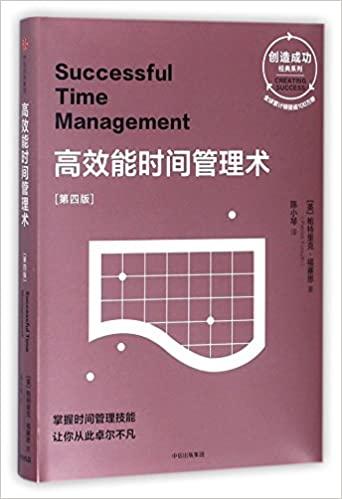Question
5. Just-in-Time (JIT) is a production strategy aimed at: a) Maximizing inventory levels b) Minimizing lead times c) Increasing batch sizes d) Reducing customer waiting
5. Just-in-Time (JIT) is a production strategy aimed at: a) Maximizing inventory levels b) Minimizing lead times c) Increasing batch sizes d) Reducing customer waiting times
6. What is the main purpose of capacity planning in operations management? a) Minimize costs b) Maximize output c) Optimize resource allocation d) Reduce waste
7. Which of the following is not a key component of Total Quality Management (TQM)? a) Continuous improvement b) Employee empowerment c) Just-in-Time (JIT) production d) Customer focus
8. The Six Sigma methodology aims to reduce defects and errors to how many standard deviations from the mean? a) 2 b) 3 c) 4 d) 5
9. Which of the following is a key concept in Lean manufacturing? a) High inventory levels b) Batch production c) Waste reduction d) Long lead times
10. What is the purpose of a Gantt chart in project management? a) Resource allocation b) Quality control c) Time scheduling d) Cost estimation
11. Which inventory management model assumes constant demand and constant lead time? a) Economic Order Quantity (EOQ) b) Just-in-Time (JIT) c) Material Requirements Planning (MRP) d) ABC analysis
12. What is the primary goal of supply chain management? a) Minimizing production costs b) Maximizing customer satisfaction c) Reducing inventory levels d) Increasing market share
13. Which of the following is not a common forecasting method in operations management? a) Exponential smoothing b) Linear programming c) Moving averages d) Delphi method
14. In the context of operations management, what does "lead time" refer to? a) The time it takes to complete a project b) The time it takes to place an order and receive it c) The time it takes to manufacture a product d) The time it takes to hire a new employee
15. Which type of layout arranges workstations in a line or U-shape to maximize the flow of materials and minimize transportation costs? a) Process layout b) Product layout c) Cellular layout d) Fixed-position layout
16. What does the term "bottleneck" refer to in operations management? a) A narrow-necked bottle used in packaging b) A constraint or limiting factor in a process c) A type of inventory item d) A quality control tool
17. What is the primary purpose of a Pareto chart in quality control? a) To display the distribution of data b) To identify the most significant factors contributing to a problem c) To calculate process capability d) To show the trend of data over time
18. Which of the following is not a key principle of the Theory of Constraints (TOC)? a) Identify constraints b) Exploit constraints c) Subordinate everything to the constraint d) Ignore constraints
19. What does the acronym MRP stand for in operations management? a) Maximum Resource Planning b) Material Resource Planning c) Manufacturing Resource Programming d) Mass Resource Production
20. Which of the following is an example of a qualitative forecasting method? a) Exponential smoothing b) Linear regression analysis c) Jury of executive opinion d) Time series analysis
21. Which of the following is not a key element of the Deming Cycle (PDCA)? a) Plan b) Do c) Control d) Analyze
22. What is the primary purpose of the Critical Path Method (CPM) in project management? a) Resource allocation b) Cost estimation c) Schedule planning d) Quality control
23. Which of the following is a key objective of inventory management? a) Maximize inventory turnover b) Minimize customer orders c) Maximize safety stock levels d) Minimize holding costs
24. Which quality control tool is used to analyze the relationship between two variables? a) Fishbone diagram b) Scatter plot c) Histogram d) Control chart
25. Which production strategy focuses on producing products based on actual customer orders? a) Make-to-Order (MTO) b) Make-to-Stock (MTS) c) Engineer-to-Order (ETO) d) Assemble-to-Order (ATO)
26. Which type of maintenance is performed before equipment fails to prevent breakdowns? a) Corrective maintenance b) Preventive maintenance c) Predictive maintenance d) Reactive maintenance
27. What does the acronym ERP stand for in operations management? a) Enterprise Resource Planning b) Efficient Resource Processing c) Economic Resource Production d) Effective Resource Placement
28. Which of the following is a key element of the 5S methodology for workplace organization? a) Sorting b) Selling c) Shuffling d) Shredding
29. What is the primary purpose of a control chart in quality control? a) Displaying data distribution b) Identifying process variations c) Calculating process capability d) Predicting future trends
30. In supply chain management, what does "bullwhip effect" refer to? a) The sound of a whip in a warehouse b) Increasing demand fluctuations as you move up the supply chain c) Decreasing demand fluctuations as you move up the supply chain d) The impact of inflation on supply chain costs
31. What is the primary goal of inventory turnover ratio analysis? a) Minimize inventory levels b) Maximize the cost of goods sold (COGS) c) Maximize the return on investment (ROI) d) Maximize customer satisfaction
32. Which of the following is a key component of the 7 wastes (Muda) in Lean manufacturing? a) Quality b) Overproduction c) Safety d) Customer satisfaction
Step by Step Solution
There are 3 Steps involved in it
Step: 1

Get Instant Access to Expert-Tailored Solutions
See step-by-step solutions with expert insights and AI powered tools for academic success
Step: 2

Step: 3

Ace Your Homework with AI
Get the answers you need in no time with our AI-driven, step-by-step assistance
Get Started


